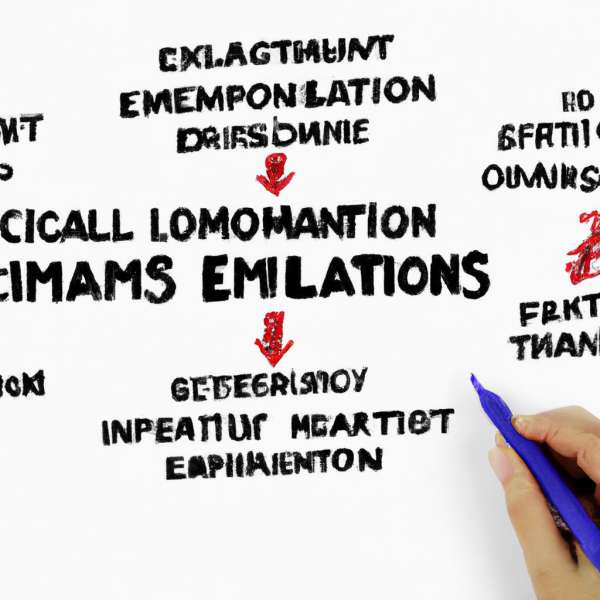Comprehending Emotional Distress Claims: Navigating the Complex Terrain of Psychological Injury
Within the multifaceted realm of the legal system, emotional distress claims serve as a stark reminder of the significant toll psychological harm can take on individuals. Unlike physical injuries that are often immediately apparent, emotional distress can be more insidious, manifesting in less visible but equally debilitating ways. These claims can arise from a wide array of situations, including car accidents, workplace harassment, breach of contract, and wrongful termination.
As society evolves towards a more sophisticated understanding of mental health, the legal system faces the challenge of recognizing and addressing emotional pain. This article explores the complexities of emotional distress claims, shedding light on the criteria required to substantiate these claims, the legal precedents that influence their outcomes, and the obstacles claimants may encounter. Whether you are a legal professional, a potential claimant, or simply an interested observer, understanding the intricacies of emotional distress claims is crucial for appreciating the intersections of law, psychology, and personal experience. Join us as we delve into the complexities surrounding this often-overlooked area of law and explore what it takes to seek justice for emotional suffering.

Foundations of Emotional Distress Claims
Emotional distress claims often revolve around the delicate balance between mental well-being and legal responsibility. At the heart of these claims is the assertion that an individual has suffered significant psychological harm due to another’s negligent or intentional actions. Understanding the various elements that constitute an emotional distress claim is essential, as they can differ significantly by jurisdiction. Generally, plaintiffs must prove that the emotional distress was severe and directly caused by the defendant’s conduct.
Legal frameworks typically categorize emotional distress into two main types: intentional infliction of emotional distress and negligent infliction of emotional distress. Each category has specific legal standards and thresholds for proving claims. For instance:
- Intentional infliction: Requires evidence that the defendant’s conduct was outrageous or extreme, and was performed intentionally or recklessly.
- Negligent infliction: Requires that the defendant’s negligence led to the emotional distress, without the need for the extreme behavior characteristic of intentional claims.
Proving an emotional distress claim often involves collecting various types of evidence. Here’s a simplified overview of common evidence considered by the courts:
| Type of Evidence | Purpose |
|---|---|
| Medical Records | To demonstrate psychological harm and treatment received. |
| Witness Testimonies | To support claims about the defendant’s behavior and its impact. |
| Personal Journals | To provide insight into the emotional toll experienced by the plaintiff. |
| Therapy Notes | To illustrate ongoing emotional struggles and professional assessments. |
Beyond the legal intricacies, understanding emotional distress claims requires a compassionate approach to the experiences of those affected. Recognizing the complexities involved in such claims not only illuminates the legal landscape but also acknowledges the profound emotional journeys that individuals endure.

Types of Emotional Distress and Their Impacts
Emotional distress can manifest in various forms, each with unique implications for the individuals involved. Understanding these types is crucial for accurately addressing their impacts on mental and emotional well-being. Below are some common categories of emotional distress:
- Anxiety Disorders: Conditions characterized by excessive worry, fear, or panic, which can disrupt daily functioning.
- Depression: A persistent feeling of sadness and loss of interest, affecting both personal and professional life.
- Post-Traumatic Stress Disorder (PTSD): A reaction to experiencing or witnessing traumatic events, often leading to intrusive memories and severe anxiety.
- Grief and Loss: The emotional pain associated with losing a loved one, leading to profound sadness and introspection.
The impacts of these types of emotional distress can be far-reaching. Not only do they affect the individual’s mental health, but they can also have significant repercussions on their personal and professional lives. For instance, anxiety disorders can lead to avoidance behaviors that hinder daily activities, while depression can result in decreased productivity and strained relationships. PTSD can cause severe disruptions in a person’s ability to function normally, and grief can lead to prolonged periods of mourning that affect overall well-being.
do they impede an individual’s capacity to sustain healthy relationships and carry out daily activities, but they can also result in physical health repercussions. For instance, persistent anxiety can lead to various health problems, ranging from migraines to digestive issues. Moreover, depression might present itself through physical exhaustion or a compromised immune system, creating a vicious cycle that exacerbates both emotional and physical suffering.
| Type of Distress | Potential Impacts |
|---|---|
| Anxiety Disorders | Elevated heart rate, sleep disruptions, difficulty focusing |
| Depression | Exhaustion, feelings of inadequacy, social isolation |
| PTSD | Recurrent flashbacks, irritability, emotional detachment |
| Grief and Loss | Profound sadness, loneliness, significant mood swings |
It is crucial to understand that these emotional responses are not just personal challenges but can also have broader social and economic impacts. Individuals may face difficulties in their professional lives, such as decreased productivity or frequent absences. Identifying the types of emotional distress is therefore essential in developing appropriate interventions and support systems, paving the way for recovery for those affected.

Navigating Legal Frameworks: Essential Considerations for Claimants
Grasping the legal landscape surrounding emotional distress claims is crucial for any claimant seeking justice. These claims often involve a complex web of regulations that differ not only by jurisdiction but also by the specifics of each case. As you navigate this intricate process, consider the following key factors:
- Jurisdictional Differences: Laws governing emotional distress can vary widely between states, impacting your ability to file a claim. Research the specific regulations in your area to determine the appropriate legal framework.
- Types of Distress: Claims may be categorized into two main types: negligent infliction and intentional infliction. Understanding the distinctions can inform your legal strategy and help establish the grounds for your claim.
- Evidence of Distress: Documentation is vital. Collect evidence such as medical records, psychological assessments, or witness statements to support your claim. The stronger your evidence, the higher the likelihood of a successful outcome.
When preparing your claim, it is also important to consider the potential defenses that could be raised against you. Some common defenses include:
| Defense Type | Description |
|---|---|
| Consent | The defendant may argue that the claimant agreed to the actions that caused distress. |
| Mitigation | The defendant could argue that the claimant did not take reasonable steps to reduce their distress. |
| Truth | If the claim involves false statements, the defendant may assert that the statements made were true. |
Ultimately, understanding these legal frameworks and their implications can empower claimants in their pursuit of emotional distress claims. Engage with legal professionals who specialize in this area to clarify your rights and enhance your chances of a favorable outcome.

Strategies to Effectively Document and Support Your Case
Effectively documenting an emotional distress claim requires a systematic approach that enhances the credibility of your case. Start by maintaining a comprehensive journal that records incidents related to your emotional distress. This journal should detail the dates, times, locations, and descriptions of events that have contributed to your distress, along with your emotional reactions and thoughts. By including specific details, you can create a compelling narrative that vividly demonstrates the impact of these events on your mental health.
Moreover, gathering corroborative evidence is essential. Examples of supportive documentation include:
- **Medical records**: Obtain reports from therapists or psychiatrists that detail your emotional state and treatment history.
- **Witness statements**: Collect accounts from individuals who can validate your experience and its effects on you.
- **Correspondence**: Save text messages, emails, or social media posts that may highlight instances of distress or distressing interactions.
Organizing this information into a cohesive format can further strengthen your case. A visual representation, such as a table, can help clarify the timeline and progression of your emotional distress. Consider the following format:
Date Incident Emotional Response
January 15, 2023 Confrontation at work Anxiety, sleeplessness
February 5, 2023 Public humiliation Depression, withdrawal
March 10, 2023 Termination letter received Panic attacks, feelings of worthlessness
**Engaging professionals**—such as therapists who can provide credible testimony regarding your emotional state—can add significant weight to your claim. Their expertise will not only demonstrate the legitimacy of your experience but also highlight the long-term effects of the distress on your daily life. By following these strategies, you can create a robust framework that effectively supports your emotional distress claim.
Conclusion
As we wrap up our discussion on emotional distress claims, it’s important to recognize that understanding these complex legal matters is as intricate as the emotions they involve. The delicate balance between law and mental well-being underscores the necessity of approaching each case with empathy and diligence. Whether you are considering filing an emotional distress claim or simply seeking to understand the intricacies involved, knowledge and clarity are your most powerful allies.
Navigating the challenges of emotional distress is not just about seeking compensation; it is about validating experiences and fostering a dialogue around mental health within our legal frameworks. With a solid understanding of the criteria, potential outcomes, and psychological dimensions at play, you can empower yourself or support others in advocating for justice and healing.
As we continue to evolve in our perception of emotional well-being in conjunction with legal rights, let us champion an approach that nurtures both understanding and support—acknowledging that every story matters and every struggle is worthy of recognition. Thank you for joining us in this important conversation.
Understanding Emotional Distress Claims
Emotional distress claims are legal actions taken by individuals who have suffered psychological trauma due to the actions or negligence of another party. These claims are essential in seeking compensation for the intangible but often devastating effects of emotional suffering.
Types of Emotional Distress Claims
- Intentional Infliction of Emotional Distress (IIED)
- Negligent Infliction of Emotional Distress (NIED)
Intentional Infliction of Emotional Distress (IIED)
This type of emotional distress claim arises when an individual acts intentionally or recklessly to cause severe emotional trauma to another person. The behavior is often outrageous and beyond the bounds of decency.
Negligent Infliction of Emotional Distress (NIED)
Unlike IIED, NIED involves situations where the perpetrator did not intend to cause emotional distress but did so through negligence. This can occur in cases like car accidents, medical malpractice, and other forms of negligence.
Criteria for Emotional Distress Claims
To successfully file an emotional distress claim, certain criteria must be met:
- Proof of Distress: The claimant must provide evidence of emotional distress, such as medical or psychological records.
- Direct Causation: The distress must be directly caused by the defendant’s actions or negligence.
- Severity: The emotional suffering must be severe and debilitating.
Legal Process for Filing an Emotional Distress Claim
Filing an emotional distress claim involves several steps. Understanding this process can improve your chances of success:
- Seek Legal Advice: Consult with an attorney specializing in personal injury or emotional distress claims.
- Gather Evidence: Collect all relevant documents, medical records, and witness testimonies.
- File the Complaint: Your attorney will help you draft and file a complaint with the appropriate court.
- Discovery Phase: Both parties will exchange information and evidence related to the case.
- Mediation/Settlement: In many cases, a settlement may be reached before going to trial.
- Trial: If a settlement is not reached, the case will proceed to trial, where both parties present their arguments.
Case Studies of Successful Emotional Distress Claims
Examining real-life examples can provide invaluable insights into the complexities and outcomes of emotional distress claims. Below are some notable case studies:
| Case | Type | Outcome |
|---|---|---|
| Doe v. Roe | IIED | $500,000 settlement for severe emotional trauma |
| Smith v. Jones | NIED | $300,000 in damages due to negligent behavior |
Benefits and Practical Tips for Filing Emotional Distress Claims
Filing an emotional distress claim can provide not only financial compensation but also a sense of closure and justice. Here are some practical tips to consider:
- Document Everything: Keep a detailed record of your emotional distress, including medical treatment, therapy sessions, and personal journal entries.
- Seek Professional Help: Consult with mental health professionals to obtain a thorough diagnosis and treatment plan.
- Legal Representation: Hire an experienced attorney to navigate the complexities of your claim.
First-hand Experience: A Victim’s Journey
Jane Doe found herself engulfed in unimaginable emotional turmoil following a harrowing car accident. The driver at fault had been texting, leading to this catastrophic event. Jane struggled with PTSD, anxiety, and depression, causing a significant decline in her quality of life.
She decided to file an emotional distress claim, guided by a compassionate and skilled attorney. Through meticulous documentation and expert testimonies, Jane built a strong case which resulted in a $400,000 settlement. This compensation enabled her to pursue intensive therapy and regain control over her life.
Common Challenges in Emotional Distress Claims
While emotional distress claims can yield significant benefits, they also come with their own set of challenges:
- Proving Emotional Distress: Unlike physical injuries, emotional suffering is not always visible, making it harder to prove.
- Subjectivity: Emotional distress can be subjective, and different individuals may experience varying levels of suffering from similar incidents.
- Legal Hurdles: Different states have varying criteria and limitations on emotional distress claims, adding a layer of complexity to the legal process.
Conclusion
Unlocking the secrets behind emotional distress claims entails understanding the types, legalities, and complexities involved in these sensitive cases. While challenges exist, thorough documentation, professional help, and experienced legal guidance can significantly enhance the chances of a successful claim.
If you’re considering filing an emotional distress claim, remember that you don’t have to navigate this challenging process alone. Seek the help of professionals to ensure you receive the justice and compensation you deserve.


